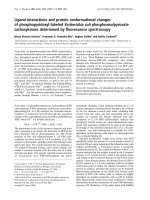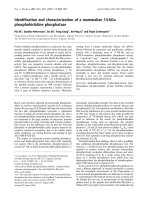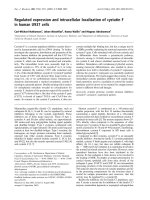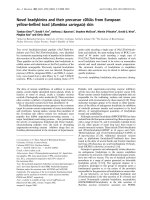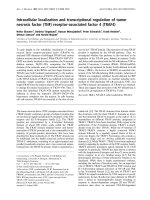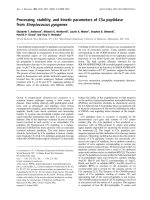Báo cáo y học: "CTLA-4 polymorphism and primary Sjögren’s syndrome: authors’ response Corinne Miceli-Richard, Jacques-Eric Gottenberg and Xavier Mariette" pdf
Bạn đang xem bản rút gọn của tài liệu. Xem và tải ngay bản đầy đủ của tài liệu tại đây (31.86 KB, 1 trang )
Page 1 of 1
(page number not for citation purposes)
Available online />We thank Dr Lester and colleagues [1] for their interest in our
recent article [2] and for their comments.
As underlined by Lester and colleagues [1], replication
cohorts are of primary importance in genetic association
studies. With regard to primary Sjögren’s syndrome (pSS),
however, it is difficult to collect a very large group of patients
and our cohort of pSS patients, even though it comprised
281 patients, remains somehow of moderate size when
compared with other cohorts of patients with closely related
auto-immune diseases such as lupus. This observation leads
us all to be very careful with the reported findings from pSS
genetic association studies. The objective of our discussion
was not to suggest that our results could be interpreted
meaningfully against those of Downie-Doyle and colleagues
[3], but to highlight the fact that contradictory results could
be observed if small populations of patients and controls are
analyzed.
As discussed in our manuscript [2], the at-risk allele found in
our first cohort of patients (CTLA-4 +49A/G*A) has been
reported to be protective in various auto-immune diseases.
These results naturally prompted us to confirm the findings in
a second cohort of patients. The results in this second cohort
were opposite to those in the first cohort and, overall, there
was no association. Our study was not restricted to individual
single nucleotide polymorphism analysis but also included
haplotypic analyses that showed an overrepresentation of
CTLA-4 +49A:CT60A and CTLA-4 +49A:CT60G
haplotypes among patients (P = 0.03, odds ratio 1.41, 95%
confidence interval [1.02 to 1.95]) in the first cohort, as
observed by Downie-Doyle and colleagues [3]. As those
haplotypes carry CTLA-4 CT60*G and CTLA-4 CT60*A
alleles, respectively, each of them having opposite functional
effects on CTLA-4 mRNA expression, we just wondered in
the discussion how such an association could be functionally
explained. In fact, the positive association reported in lupus
by Torres and colleagues [4] involved only the CTLA-4
+49A:CT60G haplotype (and not CTLA-4 +49A:CT60A,
which had a neutral effect on lupus susceptibility), which has
been demonstrated to lead to a lower level of soluble CTLA-4
at the mRNA level in unstimulated CD4 T cells. Such a
haplotype could, therefore, also be rationally considered as
an at-risk haplotype at a functional level.
Therefore, we are convinced that definite conclusions can not
be drawn on the role of CLTA-4 polymorphisms and haplo-
types in pSS disease susceptibility. For this purpose, other
replication studies have to be performed in Caucasian
patients, ideally in populations with large sample sizes, in
order to be confident that they are involved in pSS pathogeny.
Competing interests
The authors declare that they have no competing interests.
References
1. Lester S, Downie-Doyle S, Rischmueller: CTLA4 polymorphism
and primary Sjögren’s syndrome. Arthritis Res Ther 2007, 9:
401.
2. Gottenberg JE, Loiseau P, Azarian M, Chen C, Cagnard N,
Hachulla E, Puechal X, Sibilia J, Charron D, Mariette X, Miceli-
Richard C: CTLA-4 +49A/G and CT60 gene polymorphisms in
primary Sjögren syndrome. Arthritis Res Ther 2007, 9:R24.
3. Downie-Doyle S, Bayat N, Rischmueller M, Lester S: Influence of
CTLA4 haplotypes on susceptibility and some extraglandular
manifestations in primary Sjogren’s syndrome. Arthritis Rheum
2006, 54:2434-2440.
4. Torres B, Aguilar F, Franco E, Sanchez E, Sanchez-Roman J,
Jimenez Alonso J, Nunez-Roldan A, Martin J, Gonzalez-Escribano
MF: Association of the CT60 marker of the CTLA4 gene with
systemic lupus erythematosus. Arthritis Rheum 2004, 50:
2211-2215.
Letter
CTLA-4 polymorphism and primary Sjögren’s syndrome:
authors’ response
Corinne Miceli-Richard, Jacques-Eric Gottenberg and Xavier Mariette
Rhumatologie, Institut Pour la Santé et la Recherche Médicale (INSERM) U802, Université Paris-Sud 11, Hôpital Bicêtre, Assistance Publique-
Hôpitaux de Paris (AP-HP), Le Kremlin Bicêtre, France
Corresponding author: Xavier Mariette,
Published: 5 June 2007 Arthritis Research & Therapy 2007, 9:402 (doi:10.1186/ar2199)
This article is online at />© 2007 BioMed Central Ltd
See related research article by Gottenberg et al., and related letter by Lester et al., http://arthritis-
research.com/content/9/3/401
pSS = primary Sjögren’s syndrome.
